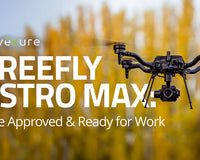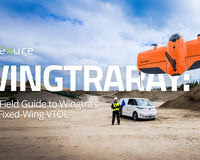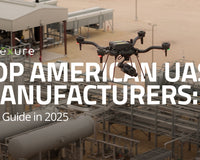Are you in search of locally-made UAS solutions for your drone program? With Freefly, you're in luck!
Freefly Systems has some all-inclusive, American-made enterprise solutions that are a great bang for your buck. Freefly Alta X and Astro have been in the market for quite a while -- Alta X in 2019, and Astro in 2020 -- establishing themselves as reliable options for a host of use-cases.
If your organization requires you to use locally-made UAS, Freefly Systems' Astro and Alta X integrate state-of-the-art technology to ensure that your missions are smoother than ever.
In this article, we dive into what sets these drones apart from the rest, so let's get right into it.
Freefly Alta X Vs. Freefly Astro
Freefly Systems is well-known for manufacturing super-resilient UAVs for cinematic, professional, and industrial applications.
Besides incorporating impressive features, Freefly guarantees its users a highly data-secure UAS. Speaking of which, the heavy-lift drone (Alta X) recently got green-lit to feature among the Blue UAS.
Related Article: 5 Blue sUAS Drones to Watch for in 2022
On Oct. 8, 2021, the Defense Innovation Unit (DIU) unveiled the Blue sUAS 2.0 program. It featured an updated list of UAVs and manufacturers that meet the usability standards for agencies under the Department of Defense (DoD).
*If you’d like to know more about Blue UAS drones, here’s an article for you: Everything You Need to Know About the Blue UAS Program.
Astro is not yet a Blue-approved drone, but it still packs a punch. A collaboration between the parent company (Freefly Systems) and Auterion saw this drone platform come to life.
Wondering how your organization may benefit from either of these industrial workhorses? More details are coming right up.

*Freefly Alta X - Image courtesy of Freefly Systems
Overall architecture and quality
Freefly's Astro and Alta X boast an open architecture that makes them incredibly modular.
Their modular design ensures they can accommodate new payload systems to enable your UAS team to complete a wide range of mission requirements.
In turn, this will save your organization lots of time, money, and effort, while simultaneously prioritizing your team's security.
Portability
Their portability ensures they easily fold into the TSA-approved hard case, thus allowing your UAS staff to transport them from one point to another conveniently.
Alta X has massive 33-inch plastic fiber-reinforced propellers that fold into half their size. Here are its dimensions for a better perspective:
Unfolded diameter (with propellers) - 89.4 inches.
Folded diameter - 34.5 inches.
Conversely, Freefly Astro is way more compact since it weighs about 15 pounds, whereas Alta X weighs a staggering 76.9 pounds. Alta X's massive weight allows it the bandwidth to carry payloads of up to 35 pounds compared to Astro, which is limited to payloads below 3.3 pounds.
Astro's small weight gives it an upper hand over Alta X since it can easily fold into a backpack with its dimensions transitioning as follows:
Unfolded diameter (with propellers) - 55.4 inches
Unfolded Height - 14.1 inches
Folded Diameter - 20 inches
Folded Height - 7 inches
If you're a little worried about the impact weight may have on the setup time, the next section further elaborates on this.
Deployability
Since no assembly of payloads is required for the Alta X - it takes slightly less time to deploy. It only needs you to unfold and latch its propellers, then attach the battery sets, and it's ready for take-off.
Astro needs exactly 1 minute and 27 seconds.
The difference between the two is probably in seconds, as Astro involves bolting on a camera payload of your choice, such as the Sony Alpha 7R IVA. The gimbals and payloads feature a quick-release system on the top or bottom that greatly save time by facilitating rapid attachment and switching.
So, now that we are on time (pun intended), how long can you fly these two around before you reach the critical battery threshold?
Flight time
The heavy-lift system Alta X has a flight time of about 41 minutes with a 5-pound payload while maintaining a 3.1:1 thrust-to-weight ratio.
However, the advertised flight time recorded while maintaining a 3.5:1 without a payload to weigh it down stands at an impressive 50 minutes.
After testing the various payloads compatible with the platform, it's pretty clear that the flight time is payload-dependent. Thus, the lighter the payload, the more the flight time, as illustrated below:
MōVI Carbon - is about 22 pounds resulting in a 22-minute flight time.
Phoenix LiDAR - is only 11 pounds, and the flight time is about half an hour.
On the other hand, Freefly Astro has an advertised flight time of 37 minutes in ideal conditions without a payload, and the number slightly goes down to 25 minutes when a 3.3-pound payload is introduced.
Nevertheless, the two have decent flight times that may give your UAS team enough time to go over half or even complete your missions.
Now that the time issue is settled, let's get into the technology that has been added to boost gimbal performance.

*Freefly Astro - Image courtesy of Freefly Systems
Gimbal performance and options
A 35-pound payload capacity makes the Alta X one of the most versatile UAVs in the market, as it can complete any aerial mission when paired with suitable payloads. It's compatible with gimbaled IR, mapping cameras, LiDAR, hyperspectral sensors, and delivery systems.
The Alta X can accommodate RTK and PPK mapping cameras that ensure your team continuously collects accurate data and LiDAR sensors that make it more appropriate for all your photogrammetry mission requirements.
Astro features one of the best full-frame high-megapixel cameras in the market- the Sony Alpha 7R IVA. Its 61-MP camera guarantees high-quality 2D and 3D outputs.
The Astro comes in two packages - Astro Base and Astro Map. The latter has PPK and RTK capabilities, and its PPK ground stations include Trimble and Emlid.
Since Astro's lightweight 3-axis gimbal is open architecture, the gimbal options aren't limited, which is a breath of fresh air.
Aren't we all tired of breaking the bank every time a new platform drops? With Freefly's Enterprise solutions, you won't have to worry about payload compatibility anymore, as the open architecture allows manufacturers to customize a list of payloads that integrate with the system. The list keeps on growing and currently includes thermal and multispectral sensors.
An advanced imaging system and other special features add great finishing touches to the overall flight performance of these platforms.
Flight performance
A flight's overall performance depends on many factors, including all we've discussed in the sections mentioned above and all we're yet to discuss in the sections down below.
Every little thing counts, from the propellers to the motors to the software and many more.
For instance, Alta's ActiveBlade is an example of a special feature that hides in plain sight but whose contribution cannot go unnoticed. ActiveBlade greatly reduces vibrations by stiffening drone components, therefore, leading to the following:
- Improved footage quality
- Minimal data distortion
- Increased lifespan of motor bearings
Astro features a newly improved motor drive design that significantly improves the platform's flight speed, noise disruption, and, ultimately, its performance.
These platforms are also easily expandable as their open architecture allows adaptability to new technologies.
Upgradability
Astro and Alta incorporate Auterion Enterprise PX4 software which works complementarily to the Auterion Mission Control on the base station. Together, they ensure that you receive LTE connectivity, geotagging, routine predictive maintenance, and seamless fleet management.
Enterprise developers can also benefit from incorporating Auterion Air, Ground, and Cloud SDK into their workflows.
The PX4 firmware's predictive maintenance ensures the airframes are always in good shape for flights by providing constant software updates.
Both their designs are custom-configured to allow future payload expansion. This much-needed and thoughtful addition saves your organization tons of money. You no longer have to worry about purchasing new cameras and sensors whenever a newly improved platform is released.
Freefly Systems also has a maintenance system to ensure that your remote pilots operate with peace of mind.
Repair and maintenance
Freefly Systems provides spare parts and offers factory checkups and repairs in the event of flight mishaps while in use during different industrial applications.
Industrial Applications
Freefly Alta X and Astro have almost similar features and capabilities.
These slight discrepancies make their use cases slightly different, with the Alta X being best for:
- Photogrammetry
- Logging,
- Agricultural inspections,
- Medical supply delivery,
- Forest inspections, and
- Infrastructure inspections.
Freefly Astro equally does well in geospatial mapping. You can also use it for wildlife and wind-turbine inspections.
Are Freefly Enterprise Drones Worth the Investment?
Freefly's Alta X and Astro bring so much to the table. Freefly Systems has performed many test runs to ensure that the drone is up to standard for any of your organization's aerial needs. They even have data to back all their tests up for avoidance of doubt.
With Advexure, you get the chance to further clear your doubts through our loaner and leaser program but first, connect with us to see if you qualify for the program. The program allows you to see how well either of these drones may fit into your use cases before investing big bucks.
One of the biggest cons that might prevent many from accessing these impressive platforms is their price points, but everything else checks the box.
There are so many pros. For instance, open architecture is a big one. In hindsight, it's a very cost-effective option as you no longer have to purchase new cameras and sensors if the need to upgrade to another Freefly platform arises.
Alta X and Astro can be flown under all weather conditions, but you're called to exercise caution and discernment.
The main difference between Astro Base and Astro Map is that the latter includes the Sony Alpha 7R IVA.
Contact us here or just open the chat box to get your risk-free quote or expert-level advice on any of your UAS needs from our UAS team.










